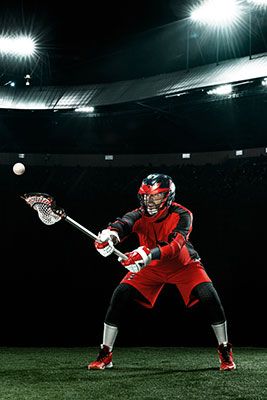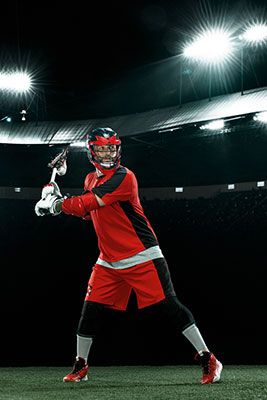Slashing fouls have become all too common for lacrosse players across the country. With the continuing growth of boys, girls, men, and women's lacrosse, understanding when these kinds of fouls are called is more important than ever before.
Keep reading to learn about what constitutes a lacrosse slashing penalty, potential player repercussions if found guilty of slashing, and specific rules that may vary from team to team.
More...
Take away key points:
If you want to know more about slashing in lacrosse, the consequences, and how players violate the rules, refer to the guide to find crucial factors regarding the penalty. Let's begin.
What is a slashing penalty in lacrosse?
A slashing penalty in lacrosse occurs when a player uses his stick to make a vicious swing or reckless swing at the opponent.
Once the offensive team makes contact with their opponent, they jeopardize the player safety standards, and the lacrosse official sanctions offensive players with an unreleasable penalty.
As lacrosse is a physical sport, once the offending team commits the penalty, the referees must ensure that the player's checks are controlled.
How does an offensive player commit a penalty?

A lacrosse slashing penalty occurs when an offending player recklessly or viciously swings his lacrosse stick at the opponent's head, legs, or body.
Referees rarely call for the slashing penalty, but players don't have to make contact for the penalty to be called. As a result, youth levels are generally the only leagues calling slashing penalties without contact.
Are slashing penalties technical fouls or personal fouls?
As they jeopardize the safety of all players, the slashing penalties are personal fouls, and major infractions, compared to minor infractions of technical fouls. Thus, the referees will call for a non-releasable penalty for the offender when the player commits the lacrosse rule violation.
How does a referee decide the degree of the slashing personal foul?
Once he calls for a slashing penalty, the lacrosse official must decide whether the player swings recklessly, viciously, or both with his lacrosse stick.
A vicious swing is when a swing that could injure the opposing team if they did not wear protective equipment. For instance, a player swings at the head of an opposing player with both hands and violates lacrosse rules.
A reckless swing is when a player cannot control his stick. For instance, one player chases possession of the ball and wildly swings the player's stick against the opponent with no aim. These moves can also be considered vicious. But, the penalty is reckless, as the player could not control the stick well.
Examples of the slashing penalty
Below are some of the most common examples of a lacrosse slashing penalty. These include:
- One player continuously swings at the opponent's head or body without attempting to dislodge the lacrosse ball
- A player swings his stick to the opponent's body or head when they don't have possession of the ball
- Although rarely called, a player swings aggressively at his opponent but does not make contact with the other team
What is the consequence of a slashing penalty?
A referee can call slashing penalties anytime during the play, and the punishment is a one, two, or three-minute non-releasable penalty, depending on the severity of the violation.
Slashing to the neck, head, or legs is penalized more strictly. In some extreme circumstances, the players can even be expelled from the play. But the shooting follow-through is not a slash, even if it makes contact with an opponent. The player is shooting, so there is no violation.
However, in all levels of US Lacrosse, the most common penalties for slashing include a one-minute of non-releasable penalty. But, if the referee calls for more severe punishment, that means the safety of the player and the play has been jeopardized.
How does a referee call for a slashing penalty?
Once the referee calls for a slashing rule violation, the official must determine the length of the penalty time the player must serve. Since it's a personal foul, the minimum penalty is one minute in the box.
The official will stop play, point to the scoring table, signal how long the penalty will be, place his left hand over his right, and cross his arms to indicate slashing.
Will a player go to a penalty box if he commits a slashing personal foul?
A player who is not ejected from the play will go to the penalty box to serve his penalty time. However, he must kneel in the penalty box during his one-minute penalty.
The other team will play with man-up, use the advantage to score a goal and turn the game to their advantage.
Can you score a goal during the slashing penalty?
Scoring a goal during a slashing penalty in lacrosse is possible, but it can depend on the severity of the offense.
If a player commits a major foul, such as slashing or cross-checking another player, they must immediately exit the field for three minutes.
During those three minutes, if their team regains possession and can take the ball into their offensive half of the field, then there is a chance they could score a goal while the player who committed the foul is still serving their penance.
However, it cannot be guaranteed because unless the team were in possession when the infraction occurred, it would be difficult while one man down to establish offensive pressure and press forward enough to get a shot off.

Similar penalties to slashing in the game
We have included some of the most common infections similar to the slashing penalty in lacrosse. The most frequent ones include: pushing, illegal body check, illegal cross-check, unnecessary roughness.
Pushing
Pushing in lacrosse is a term used to describe an action in which a player shoves or thrusts his opponent from behind.
Pushing is allowed from the side or front when the opponent is within five yards of the loose ball or is in possession of the ball. Thus, both hands must be on the stick, and pushing must be done with a forearm, shoulder, or closed hand.
Illegal body checking
Illegal body checking is when a player checks his opponent from behind, above the shoulders, or below the waist.
Illegal crosse-checking
Illegal crosse-checking when playing lacrosse occurs when a player spreads his hands apart on his stick and uses his shaft to push the opponent rather than using his hands.
Unnecessary roughness
Unnecessary roughness in lacrosse is a type of unsportsmanlike conduct when a player uses a check deemed violent, deliberate, and avoidable.
Summary
Slashing in lacrosse is a personal foul that comes with stricter punishments and risks severe injuries to players. It also greatly affects the game, making it less enjoyable for everyone involved.
If you are caught slashing, you will be penalized and may even be ejected from the game.
So next time you think about doing it, remember the consequences and enjoy playing the sport correctly.
